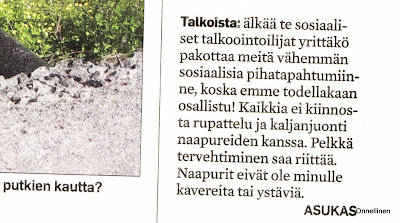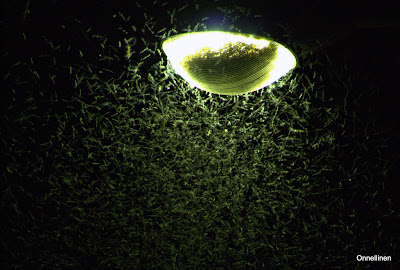Sigh! Said good bye Japan on Aug 5.
It was one of the best years of my life. But the chapter of Japan isn't over yet. I refuse to close it. Why? Oh, no, I don't miss working 10 hours a day, neither do I miss dehydrating at +35 degrees, nor the uninvited cockroaches. What then? In one word, there are too many good people I like and miss too much! And the fix? Reopen and continue the Japan chapter one day.
What happened to everyone else?
Some of the other exchange students had sad postings about the way back, and how they had dealt with or fought against their emotions. I bet part of their thoughts are pulling them back to Japan. Also I believe they see their home countries in a different light. While some of the lucky ones still were continuing their exchange, a new batch of students arrive to Oita and starting their studies. I wish all the best for them!
How about our journey back?
For me the worst phase was the three-hour bus ride from Helsinki to home. In all its emptiness it characterizes Finland accurately: straight roads, flat landscapes, nothing to see but trees that swoosh past the bus window. Add the fact that only a handful of passengers occupy the bus.
This is alone country where it is easy to yearn for something else (like Japan). But as always, we get used to it. The short days, cold nights and rainy mornings are temporary. And even in those grey days there is some everyday-aestheticism and peace. Picture: sitting at the morning breakfast table looking outside and holding a steaming cup of honey tea with both hands. Outside the first snow quietly falls down. Those moments... Ok, ok I admit it. I'm a Finn and I suck at being poetic.
Let's go back in time and see what happened in Japan before our departure.
It was just last month but feels like a long forgotten dream already. The internship finished and was followed by a farewell party. We had a great time whole night. The boss's characterful wife was there too. She made the evening unforgettable. First of all her straight talk made me drink more than I can remember. She drove us from place to another with a caravan of taxis, offered farewell gifts more than I could carry with two hands, and well, paid the fun. I can't thank enough her and all the people that took part! Back at the student dorm, though it was almost morning, I met a familiar group: Zach, Victor, Amash, Kelly and Yuta who were having a party of some sort and chatting at the lobby entrance. Couldn't resist a talk with them. That night ended up being all but sleeping.
Gaa! We had to move on the next day!
On the morning after the get-together, which resulted in worse futsuka-yoi (hangover) than all the nomikai's (company drinking parties) combined, Yumiko and I had to empty the apartment from all the stuff that had piled up during the year. The moving day, which was Saturday, was blessed with an unimaginably hot weather. Later it resolved that it was the beginning of the hottest summer in Japan in over 110 years. Soaked in sweat that was partly caused by the trembling hangover and partly by the frying sunshine, I hoped for Superman to come and carry the moving boxes out and into our car.
I guess Superman was busy ironing his red cape, but instead Soren (Danish exchange student who currently studies in Tokyo), Yuta (the International House assistant and a student in Oita Uni.), and Raymond, (a Japanized professor who teaches in Oita Uni. and APU) came to give us a hand.
The room that had served us cozily for 11 months and faithfully provided a continuous flow of cockroaches was finally empty. I might even say we left it in better condition than what it was when we moved in. Then early on the following morning, without a proper good bye we left off to Saiki, a small city south of Oita, to catch a ferry over the Inland Sea to the island of Shikoku. The sun was already high as the ferry took of from the port of Saiki. We waived a goodbye to Oita from the deck.
Away from Oita
Our car, the compact Toyota Isto from Yumiko's parent's, aka Silver Bullet, was to take us crisscross Shikoku. First destination was a tiny island called Kashiwajima at the south-western coast. In all its quietness the idyllic town and the waters that surround the island offer some of the best diving spots in Japan. To my eyes the water was admittedly clearer than anywhere else in Japan, and a glimpse beneath the surface proved it: the reefs bustle with colorful sea life. We intended to camp there for one night, though Kashiwajima offers a lot to explore for several days.
Let me telly you how I almost drowned there.
We had mounted our tent on Kashiwajima's end, right next to where two bridges connect the island to the mainland of Shikoku. On the same spot a lovely beach half surrounds the free camping area.
It didn't take long after we were swimming at this narrow water passage in between. Again, the water was unbelievably clear. But soon we figured that without diving goggles it was no fun. "It would be nice to rent two snorkeling gear sets," said Yumiko, and pointed at a diving shop on the opposite shore. I was already splashing in the water and reckoned that the quickest way to get to the store was to swim over the strait.
Oh man, great idea! I swam three quarters of the 90-meter water passage with ease. Soon I'd be on the other side, I anticipated. Not quite so. To my grief in the remaining 10 meters the current turned extreme and started to drift me to the open sea! The more I crawled the stronger the current became. Obviously the deepest part of the strait had been on the farside, and what is more the tide was vast on time of the day. Nobody, not even Yumiko had noticed the danger I was in. Out of options and in panic I concentrated my efforts and propelled forward, but also away from the shore ahead.
Suddenly a rock that was about half a meter below the surface appeared and I got a hold of it. The rock's surface was covered entirely by seashells as sharp as thousand razors. My hands and feet were totally gashed in deep cuts as I struggled to get a grip of the stone.
Laboring my self up to dry land and getting to an upright position, I looked down and saw my hands, knees and feet dripping allover in a mixture of blood and sea water. It must have been an eye dropping sight for the dive shop keeper when I knocked on their door. And it would have been better to ask for bandages rather than for some snorkeling gear. Snorkeling and relaxing at the same time was quite impossible after this dreadful event.
Evening came and we withdrew to our brown tent, given by us by Lei Lei a Chinese grad student. Still keeping the zipper door open we enjoyed an amazing sunset. No, I will never attempt to swim across a strait again...






















